Chess is described as a ‘board’ game, but let’s ask a crazy question, “Is chess really a board game?”. This question seems crazy to a beginner, but this is a valid question for an amateur or a professional player. It is unjust to limit chess as a ‘board’ game. It is a ‘mind’ game that can even be played without a board. Wait! What?? Yes, you heard that right. Chess can be played without a board. But how is that possible? This is made possible by what we call chess notation.
Chess notation is a way of recording the moves in a chess game or the position of pieces on a chessboard. The two most common chess notations are descriptive notation and algebraic notation. The descriptive notation was used until about 1980 and was replaced by the superior algebraic notation. The algebraic notation, being more concise, is now the only notation recognized by FIDE, the World Chess Federation. Hence let’s take a look at the algebraic notation.
The Basic Notation
The algebraic notation is based on a system of coordinates to uniquely identify each square on the chessboard. Before discussing this, let’s understand two basic terminologies in chess: files and ranks. The columns on a chessboard are called files, and the rows on a chessboard are called ranks. There are eight columns on a chessboard, meaning there are eight files. There are eight rows on a chessboard, meaning there are eight ranks. Each file and rank is assigned a separate coordinate as given below.
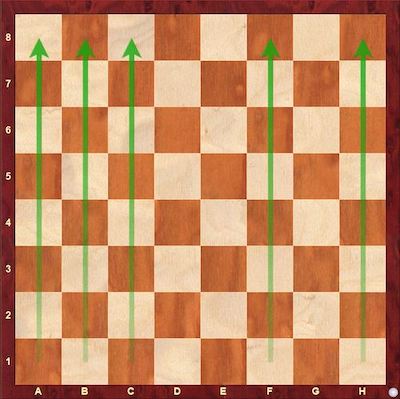
Diagram-1 indicates the files on the chessboard. From left to right, the highlighted files are the a-file, b-file, c-file, f-file, and h-file (we denote the files using the letters indicated below the chessboard).
Note: The letters used to denote the files are lowercase letters.
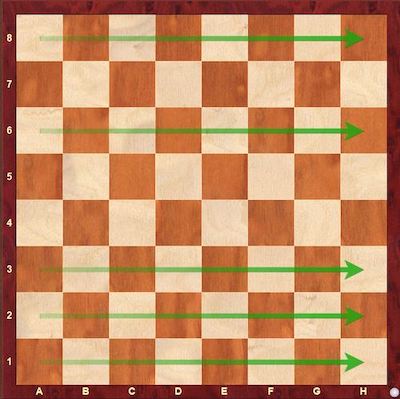
Diagram-2 indicates the ranks on the chessboard. From bottom to top, the highlighted ranks are the 1st rank, 2nd rank, 3rd rank, 6th rank, and 8th rank (we denote the ranks using the numbers indicated on the left of the chessboard).
Now let’s find out how this will help us with the notation.
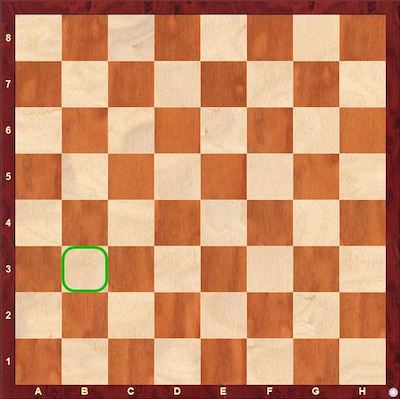
In diagram-3, the square highlighted is on the b-file as well as on the 3rd rank. Also, this is the only square that belongs to the b-file as well as the 3rd rank. This shows that each square on the chessboard can be uniquely identified with the help of the files and ranks. This is the basic idea of the notation. The highlighted square in diagram-3 is b3 (since it is a square on the b-file and the 3rd rank).
Note: While naming a square, the file name should be mentioned first, followed by the rank name.
Diagram-4 shows the chessboard with the notation for each square.
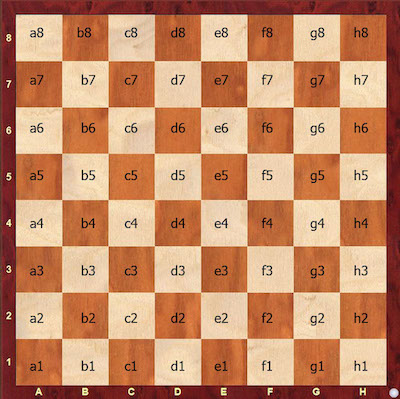
As we’ve learned how to write the basic notations, let’s move on to our main goal: learn how to record the moves. But before that, we need to learn a few symbols as well.
Chess notation symbols
Each piece is assigned a specific symbol which is helpful when writing the notation. The Symbols used to represent the pieces are as follows:
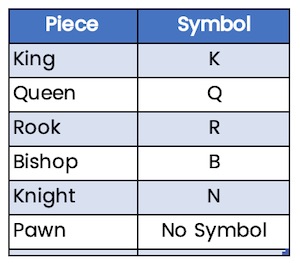
Note: Note that the symbol for each piece is the first letter of that piece, except for the knight, whose symbol is ‘N’ (This is because the king is assigned the symbol ‘K’).
There are a few more standard symbols that you should be familiar with. They are:
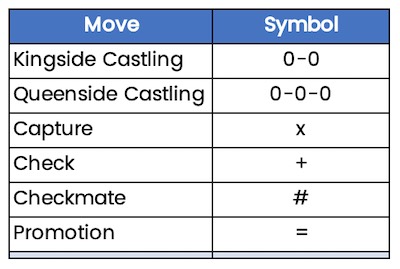
Now that we’ve all the required knowledge to write notations let’s study how to write the algebraic notation.
The Algebraic Notation
As we have discussed before, algebraic notation is very concise and easy to learn. Let’s discuss the rules for writing the notation first, which will then be followed by several examples to help understand it better. For the sake of explanation, we will divide the rules into two parts:
1. Rules to notate piece moves
2. Rules to notate pawn moves.
Notation rules for the piece moves
- The symbol for the piece moved comes first.
- The symbol for capture comes second (If the move is a capture, otherwise, it can be omitted).
- The notation of the square to which the piece moved/captured comes third.
- The symbol for check/checkmate comes last (If the move is a check/checkmate, otherwise it can be omitted).
Note: If two similar pieces can move to the same square, then it is necessary to specify the file/rank (whichever differentiates the position of the moved piece from the other) of the moved piece. Also, this should be written in the second position of the notation, just after the symbol of the moved piece.
Notation rules for the pawn moves
- Normal move
a. Unlike pieces, the pawn doesn’t have a symbol. Hence, a pawn move is denoted by the square to which it moves.
b. The symbol for check/checkmate comes next (If the move is a check/checkmate, otherwise, it can be omitted). - Capture by a pawn
a. The file on which the pawn was before capturing comes first.
b. This is followed by the symbol for capture.
c. The square to which the pawn captured comes next.
d. The symbol for check/checkmate comes next (If the move is a check/checkmate, otherwise it can be omitted). - Pawn Promotion moves
a. The pawn move/capture, described by rule-1(A)/rule-2(A, B, C), comes first.
b. This is followed by the symbol for promotion.
c. The symbol of the piece to which the pawn promotes comes next.
d. The symbol for check/checkmate comes last (If the move is a check/checkmate, otherwise it can be omitted).
Things to remember:
- A pawn move is denoted by the square to which it moves.
- In the case of a piece move, the symbol of the piece comes first.
- The symbol for capture comes after the symbol of the piece/ the pawn’s file before capturing.
- The symbol for check/checkmate comes last.
- If two similar pieces can move to the same square, then the file/rank of the moved piece comes after the symbol of the piece.
Chess Notation Examples
The rules discussed above provide a guideline on how the notation for each move is written. However, these rules might be confusing. Hence, for better understanding, let’s look at some examples.
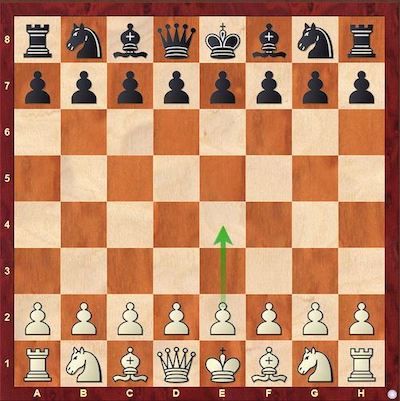
Diagram-6 shows the initial position. The highlighted move in the position is the pawn on e2 moving to e4. So, how can we notate this move? Yes! You’re right if your answer is e4 (pawn moves are indicated by the square to which it moves).
If we apply the same idea in diagram-7, we find that the highlighted move is d5.
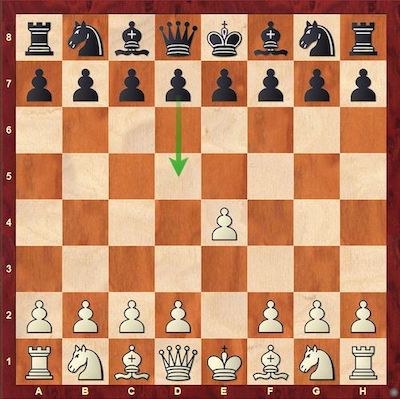
Now let’s move to diagram-8 and try to identify the highlighted move.
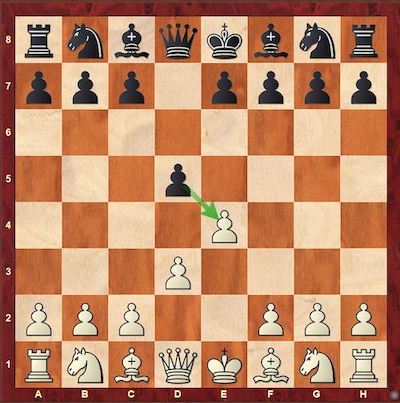
The highlighted move in diagram-8 shows a capture by the d-pawn (pawn on the d-file) to the square e4. Hence, by applying the pawn capture rule (rule-2), we can notate this move as dxe4.
Now that we know how to notate pawn moves and pawn captures let’s bring up a tricky question, “What if the pawn capture is an en passant?” The answer is relatively simple; we follow the same idea. Let me clarify this with the help of an example.
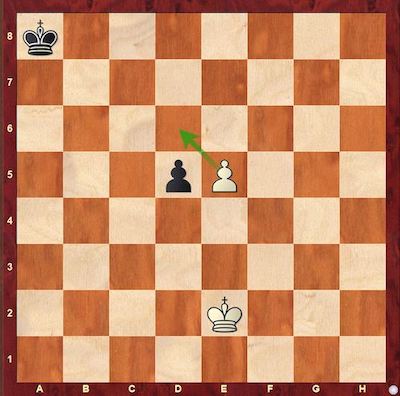
Consider the position in diagram-9 where the Black pawn has just moved from d7 to d5. This indicates that the White pawn on e5 can do an en passant and capture the Black pawn to arrive at the square d6. This can be notated using the same rule (rule-2) that we’ve applied above. Therefore, the move is exd6.
Now let’s deal with two positions that involve promotion.
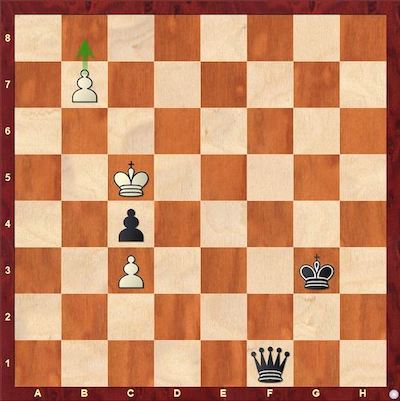
Diagram-10 shows the White pawn moving to b8 and getting promoted to a queen. But there’s something else that we have to notice, which is different from the positions that we’ve covered. Once the pawn promotes to a queen, the Black king gets checked by the newly promoted queen. This means that we have to add the ‘+’ symbol at the end. Hence, using rule-3 (promotion), we can write the move as b8=Q+ (b8 is the pawn move, ‘=’ is the symbol for promotion, and Q is the symbol for the queen, the promoted piece, and ‘+’ is the symbol for check).
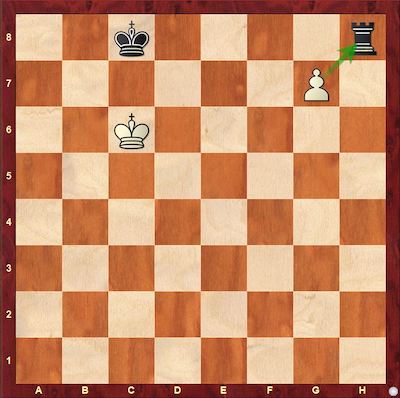
Diagram-11 shows the White pawn on g7 capturing on h8 and promoting to a rook (which checkmates the Black king). As it should be clear by now, the move is gxh8=R# (gxh8 is the pawn capturing on h8, ‘=’ is the symbol for promotion, R is the symbol for rook, and ‘#’ is the symbol for checkmate).
Now that we’ve discussed the notations for all sorts of pawn moves lets now focus our attention on piece moves.
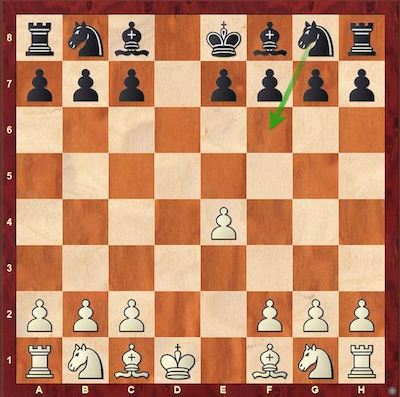
The highlighted move in diagram-12 is the Black knight moving to f6. Using the rules that we’ve discussed, we can notate this move as Nf6 (N is the symbol for the knight, and f6 is the square to which it moves).
That was rather simple, so let’s discuss a position where the move is a capture.
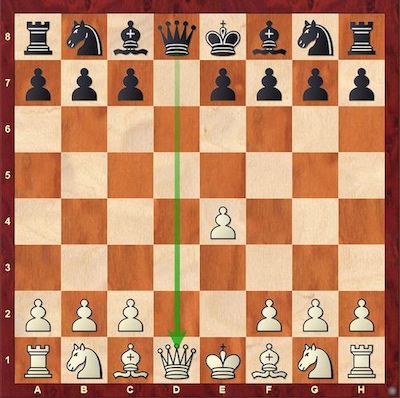
Digram-13 shows the Black queen capturing on d1 with a check. Hence, the move is Qxd1+ (Q is the symbol for the queen, ‘x’ is the symbol for capture, d1 is the square to which the queen captures, and ‘+’ is the symbol for check).
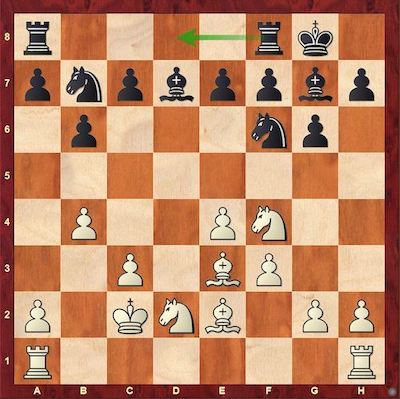
We have a tricky situation in diagram-14, where the rook on f8 moves to d8. The usual notation Rd8 is wrong here as both the rooks (f8 and a8) can move to d8. Hence, it is necessary to point out that the rook on the f-file (both the rooks are on the same rank) moved to d8. Therefore, the notation is Rfd8 (refer to the note with the rules on piece moves).
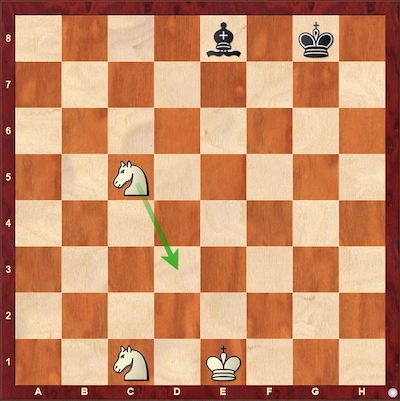
We have a somewhat similar situation here (diagram-15). The only difference with the previous position is that both the knights are on the same file. This means that the differentiating factor is the rank (1st rank and 5th rank). Therefore, the notation is N5d3.
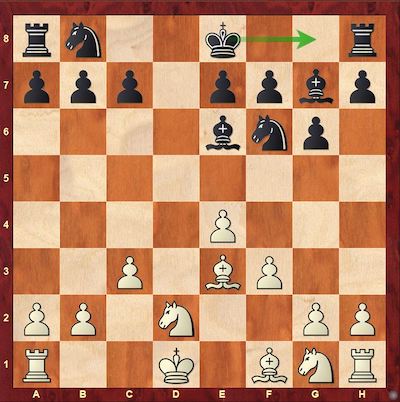
Now, let’s discuss our final example (diagram-16). The highlighted move in the position is Black castling kingside. We have a symbol for kingside castling (0-0), which itself is the notation. Therefore, the notation for the move is 0-0.
As a final touch, given below is the notation of a game. Go through the notation and try to replay the game on your own.
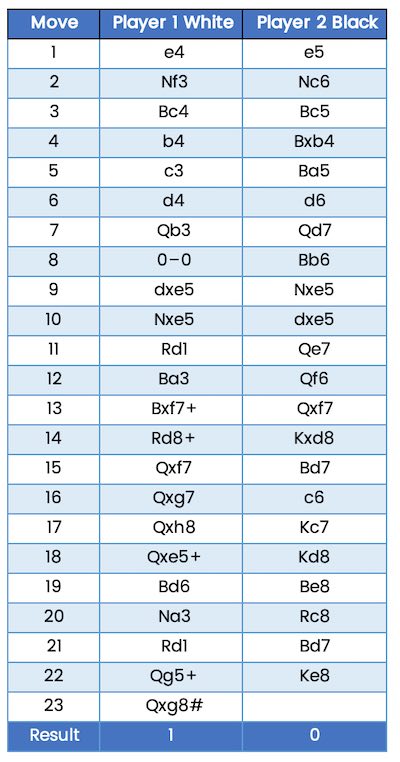
1-0 at the end of the game indicates that White won the game.
If the Black wins, it will be 0-1 and for a Draw, it will be 1/2 – 1/2
Conclusion
Learning to write the notation is a basic requirement for any chess player. This will aid you while going through chess books and articles or while watching a chess video. Now, as you know how to record your moves, you can record your games, play through them and analyze them. Above all, now you know the secret to playing chess without a board!
To learn more about chess moves and strategies, attend our online classes by signing up here.

